Food Additives Market Size
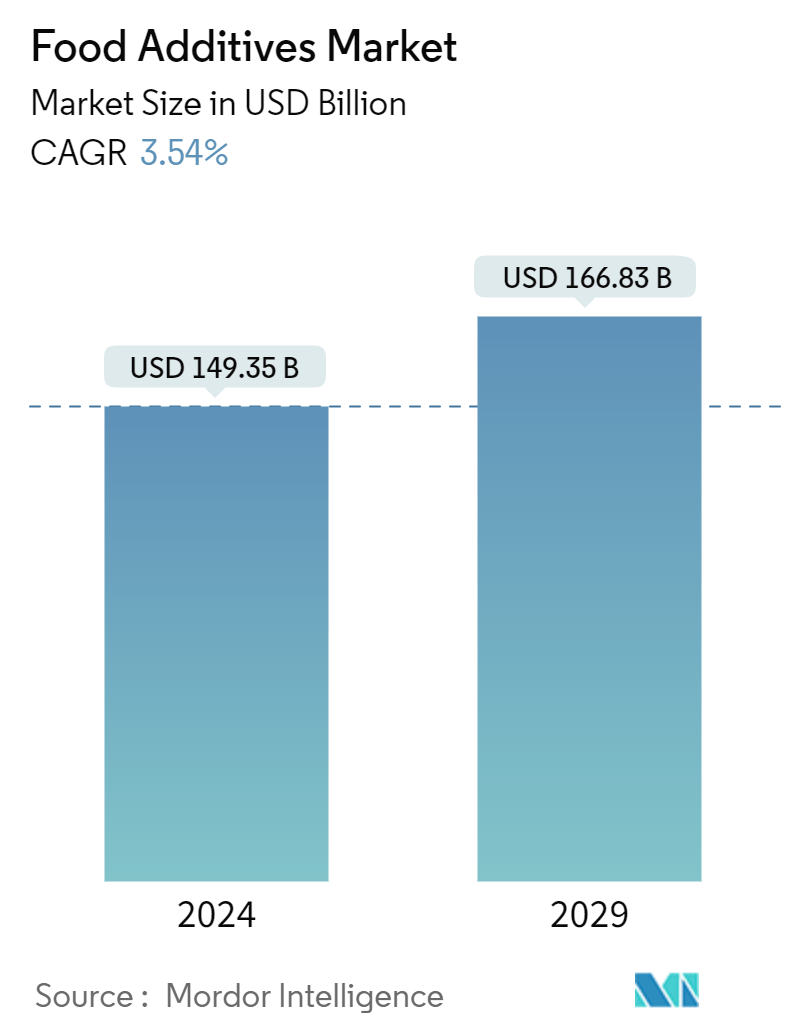
| Study Period | 2019 - 2029 |
| Market Size (2024) | USD 149.35 Billion |
| Market Size (2029) | USD 166.83 Billion |
| CAGR (2024 - 2029) | 3.54 % |
| Fastest Growing Market | Asia Pacific |
| Largest Market | North America |
| Market Concentration | Low |
Major Players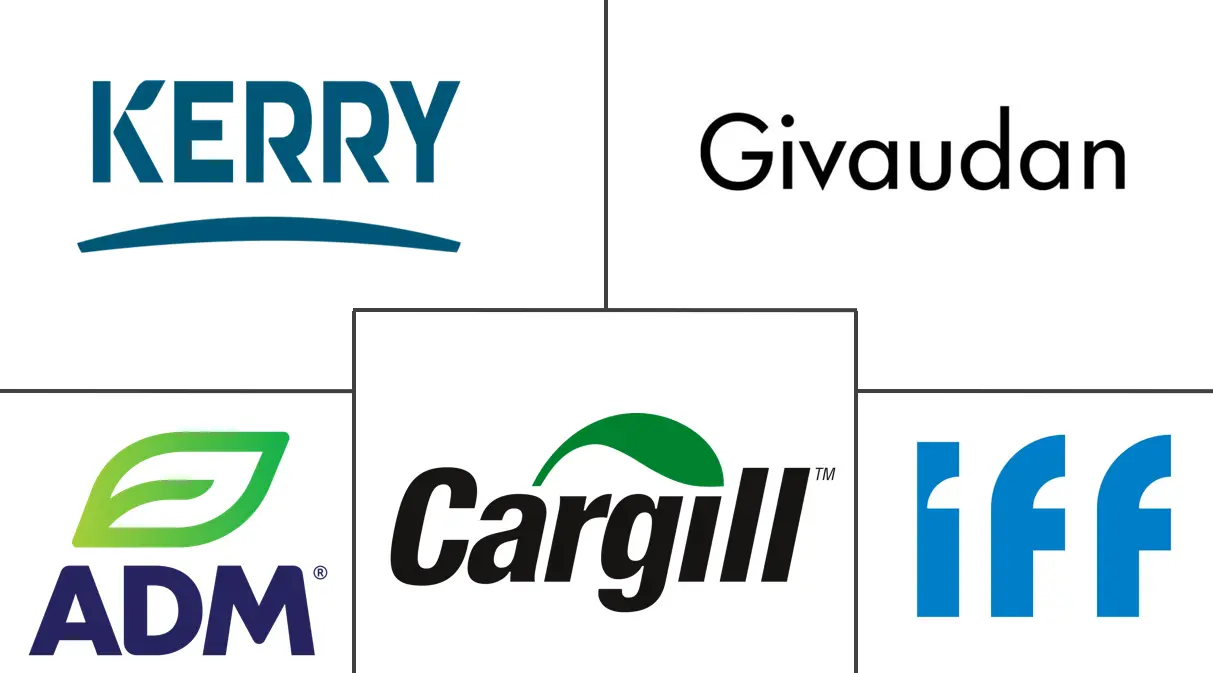
*Disclaimer: Major Players sorted in no particular order |
Food Additives Market Analysis
The Food Additives Market size is estimated at USD 149.35 billion in 2024, and is expected to reach USD 166.83 billion by 2029, growing at a CAGR of 3.54% during the forecast period (2024-2029).
Driven by their multifunctionality, food additives like sweeteners, organic acids, and hydrocolloids are witnessing a surge in demand. These additives play diverse roles in food manufacturing, from structuring food and beverages to enhancing their nutritional profile and flavor, making them increasingly sought after by food companies. The market growth is further fueled by a rising appetite for convenience, ethnic, and processed food products, amplifying the need for advanced food packaging and processing solutions. Additives are extensively used to maintain the freshness, safety, taste, appearance, and texture of these processed and convenience food products. A testament to this trend, a 2023 survey by plant technology firm Ayana Bio, dubbed the “Ultra-processed Food Pulse survey,” revealed that 82% of U.S. adults incorporate ultra-processed foods into their diets. Technologies at the forefront of the Industrial Revolution 4.0, such as artificial intelligence (AI) - encompassing CNN, ANN, fuzzy logic, and machine learning - are revolutionizing the production of ingredient additives. These technologies ensure the additives are cost-effective and nutrient-rich and optimize key attributes like high bioactive content (e.g., antioxidants), sustainability, authenticity, stability, and purity. Responding to the rising demand for sustainable food products with ethical claims, major ingredient companies like Cargill Inc. and Archer Daniels Midland Company are leveraging AI tools in their supply chains. This integration fosters transparency, bolstering consumer trust and brand loyalty. The global trend towards plant-based food is amplifying the demand for natural and clean-label ingredients, particularly in categories like colorants, acidulants, and hydrocolloids. Labels boasting terms like GMO-free, natural preservatives, and organic are significantly propelling market growth. Given the worldwide uptick in processed food consumption and a preference for organic additives, the demand for food additives is poised to rise in the medium term.
Food Additives Market Trends
Demand for Bakery and Confectionery Drives the Use of Additives
Shifting customer preferences are fueling the demand for food additives. The rising demand for functional ingredients in bakery and confectionery products is largely attributed to their nutritional benefits. Bakery staples, including bread, buns, and biscuits, are integral to daily consumption. This widespread use across various regions is bolstering the market for food additives, encompassing flavors, preservatives, and emulsifiers. Emulsifiers play a pivotal role, offering benefits like protein strengthening, starch complexing, and aeration, making them indispensable in products like bread, biscuits, and cakes. Industrial bread production increasingly relies on emulsifiers, dough strengtheners, and dough softeners. Confectionery items, from chewing gums and chocolates to gummies, fillings, hard candies, marshmallows, and water jelly, also heavily incorporate food additives. Furthermore, bakeries and confectioneries frequently turn to artificial sweeteners to lower sugar content without sacrificing sweetness, a move that resonates with health-conscious consumers. Data from LocalCircles in 2023 highlighted that in India, 37% of artificial sweetener consumption was in food and drinks, with sugar-free gums trailing at 32%. Such extensive use of food additives in the bakery and confectionery sectors propels market growth.
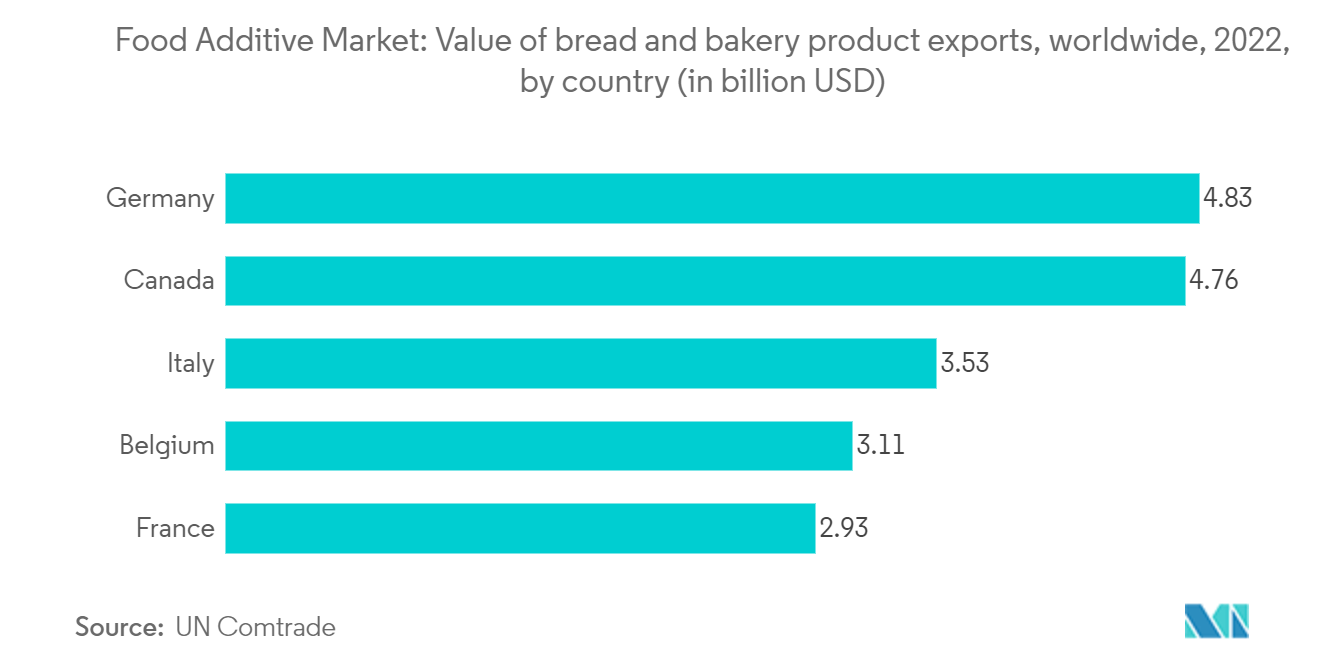
North America Dominates the Market
The food and beverage additives market is experiencing significant growth due to the increasing demand for packaged food products. According to US News, over half of the packaged food and beverage products purchased by US households in 2019 contained three or more additives. By 2023, approximately 60% of the purchased foods included coloring or flavoring agents, preservatives, and sweeteners.
In Canada, the dominance of processed food and drink products (UPF) in the food supply, alongside their escalating sales and consumption trends, has led to an increased reliance on packaged, processed food items. As per the Food & Nutrition Policy for Public Health report, these items accounted for approximately 75% of the Canadian food supply during 2021-2022.
According to Mexico Food export reports, the Mexican food sector ranked as the third-largest processed food producer in the Americas, following the United States and Brazil in 2022. Also, the USDA 2022 report states that the bakery and tortilla sector stands out as the primary subsector in Mexico, contributing 30% to the overall GDP of the processed food industry, with meat and dairy products following closely behind. The corn tortilla is the primary staple food in the Mexican diet, with a per capita tortilla consumption of 75 kilograms (kg) per year as per USD Reports 2022. Moreover, the increasing consumption of beverages plays a pivotal role in driving demand for food additives in Mexico.
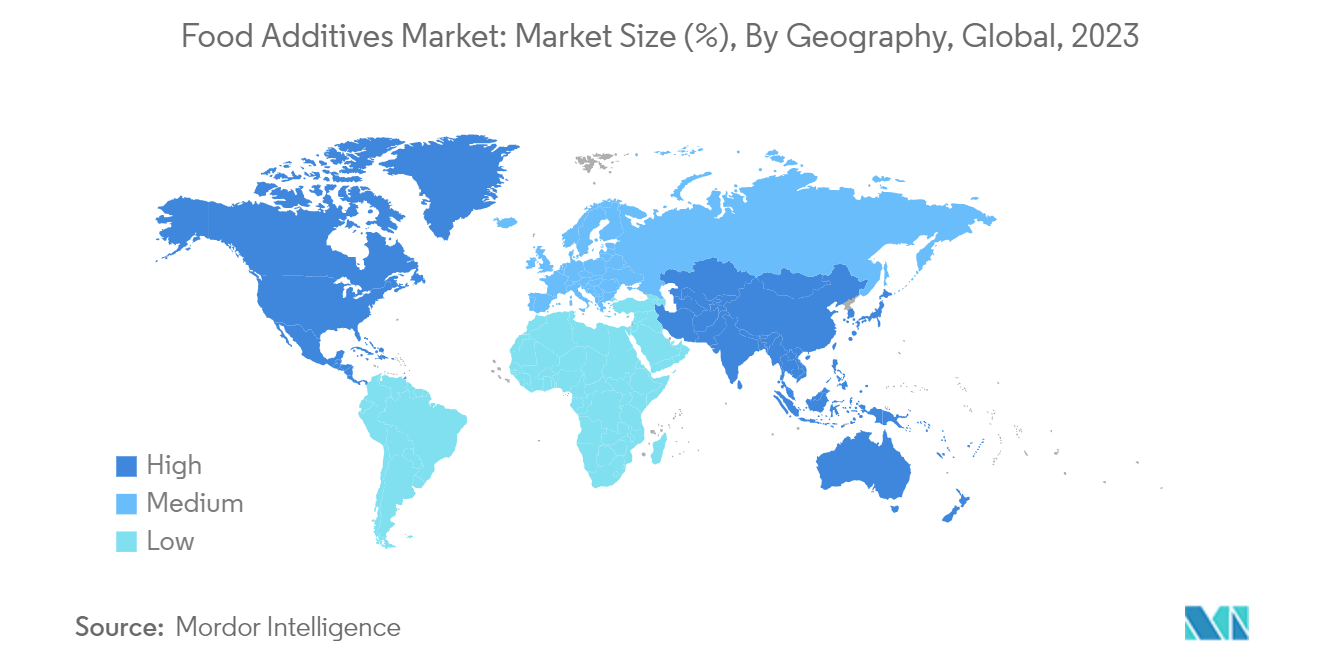
Food Additives Industry Overview
The global food additives market is highly competitive, with different regional and global players dominating the market. The prominent players in the market include Cargill Incorporated, Archer Daniels Midland Company, International Flavors and Fragrances Inc., Kerry Group, and Givaudan SA. These leading companies focus on mergers, expansion, acquisitions, partnerships with other companies, and product development as strategic approaches to boost their brand presence across different regional markets. The players have also been using aggressive advertising and promotional strategies to boost their brand image in the market studied.
Food Additives Market Leaders
-
Cargill, Incorporated
-
Archer Daniels Midland Company
-
International Flavors and Fragrances Inc
-
Kerry Group
-
Givaudan SA
*Disclaimer: Major Players sorted in no particular order
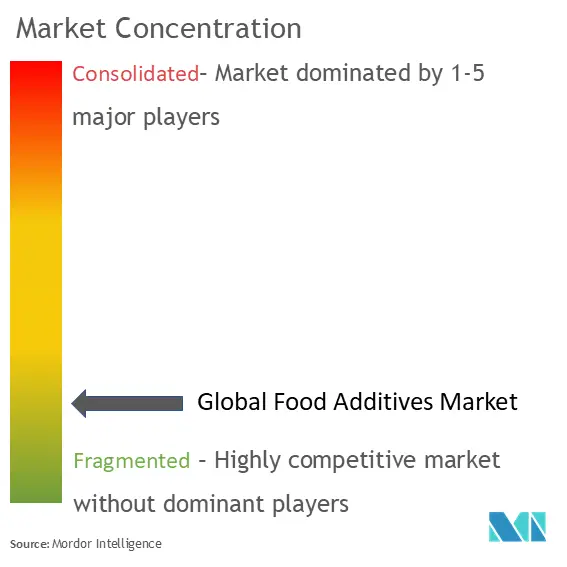
Food Additives Market News
- August 2024: Tate & Lyle launched Optimizer Stevia 8.10, a new stevia formulation designed to provide manufacturers with a budget-friendly sweetener alternative. Optimizer Stevia 8.10 closely mimics the taste of sugar, even at elevated sugar replacement ratios. This stevia variant is more economical, delivering enhanced value over other premium stevia sweeteners.
- June 2024: Azelis, a prominent player in the specialty chemicals and food ingredients sector, signed a distribution agreement with BASF. BASF is known for developing sustainable, high-quality nutritional ingredients. Effective immediately, Azelis will distribute BASF's range of emulsifiers, Medium-Chain Triglyceride (MCT), phytosterol ester, and Conjugated Linoleic Acid (CLA). These ingredients are primarily used in bakery products, beverages, and nutritional enhancements for both the retail and food service sectors.
- June 2024: Azelis, a leading innovation service provider in the specialty chemicals and food ingredients sector, announced a new distribution agreement with Tate & Lyle. This partnership offers healthier ingredient solutions for food and beverages, targeting customers in Türkiye.
Food Additives Market Report - Table of Contents
1. INTRODUCTION
1.1 Study Assumptions and Market Definition
1.2 Scope of the Market
2. RESEARCH METHODOLOGY
3. EXECUTIVE SUMMARY
4. MARKET DYNAMICS
4.1 Market Drivers
4.1.1 Consumer Demand For Processed Food
4.1.2 Rise Of Shelf-Stable Products
4.2 Market Restraints
4.2.1 Stringent Government Regulations
4.2.2 Health Impact Of Food Additives
4.3 Porter's Five Forces Analysis
4.3.1 Bargaining Power of Suppliers
4.3.2 Bargaining Power of Buyers
4.3.3 Threat of New Entrants
4.3.4 Threat of Substitute Products
4.3.5 Degree of Competition
5. MARKET SEGMENTATION
5.1 Product Type
5.1.1 Preservatives
5.1.1.1 Natural
5.1.1.2 Synthetic
5.1.1.2.1 Sorbates
5.1.1.2.2 Benzoates
5.1.1.2.3 Other Preservatives
5.1.2 Bulk Sweeteners
5.1.2.1 Sucrose
5.1.2.2 Fructose
5.1.2.3 High-fructose Corn Syrup
5.1.2.4 Lactose
5.1.2.5 Other Bulk Sweeteners
5.1.3 Sugar Substitutes
5.1.3.1 Sucralose
5.1.3.2 Xylitol
5.1.3.3 Stevia
5.1.3.4 Aspartame
5.1.3.5 Saccharin
5.1.3.6 Other Sugar Substitutes
5.1.4 Emulsifiers
5.1.4.1 Mono- and Di-Glycerides and Derivatives
5.1.4.2 Lecithin
5.1.4.3 Sorbate Esters
5.1.4.4 Other Emulsifiers
5.1.5 Anti-caking Agents
5.1.5.1 Calcium Compounds
5.1.5.2 Sodium Compounds
5.1.5.3 Silicon Dioxide
5.1.5.4 Other Anti-caking Agents
5.1.6 Enzymes
5.1.6.1 Carbohydrases
5.1.6.2 Proteases
5.1.6.3 Lipases
5.1.6.4 Other Enzymes
5.1.7 Hydrocolloids
5.1.7.1 Starch
5.1.7.2 Gelatin
5.1.7.3 Xanthan Gum
5.1.7.4 Other Hydrocolloids
5.1.8 Food Flavors and Enhancers
5.1.8.1 Natural Flavors
5.1.8.2 Synthetic Flavors
5.1.8.3 Flavor Enhancers
5.1.9 Food Colorants
5.1.9.1 Synthetic Food Colorants
5.1.9.2 Natural Food Colorants
5.1.10 Acidulants
5.1.10.1 Citric Acid
5.1.10.2 Phosphoric Acid
5.1.10.3 Lactic Acid
5.1.10.4 Other Acidulants
5.2 By Application
5.2.1 Bakery and Confectionery
5.2.2 Dairy and Desserts
5.2.3 Beverages
5.2.4 Meat and Meat Products
5.2.5 Soups, Sauces, and Dressings
5.2.6 Other Applications
5.3 Geography
5.3.1 North America
5.3.1.1 United States
5.3.1.2 Canada
5.3.1.3 Mexico
5.3.1.4 Rest of North America
5.3.2 Europe
5.3.2.1 Germany
5.3.2.2 United Kingdom
5.3.2.3 Spain
5.3.2.4 France
5.3.2.5 Italy
5.3.2.6 Russia
5.3.2.7 Rest of Europe
5.3.3 Asia-Pacific
5.3.3.1 China
5.3.3.2 Japan
5.3.3.3 India
5.3.3.4 Australia
5.3.3.5 Rest of Asia-Pacific
5.3.4 South America
5.3.4.1 Brazil
5.3.4.2 Argentina
5.3.4.3 Rest of South America
5.3.5 Middle East and Africa
5.3.5.1 Saudi Arabia
5.3.5.2 South Africa
5.3.5.3 Rest of Middle East and Africa
6. COMPETITIVE LANDSCAPE
6.1 Strategies Adopted by Leading Players
6.2 Market Share Analysis
6.3 Company Profiles
6.3.1 Cargill Incorporated
6.3.2 Ajinomoto Co. Inc.
6.3.3 BASF SE
6.3.4 Eastman Chemical Company
6.3.5 Archer Daniels Midland Company
6.3.6 Tate and Lyle PLC
6.3.7 AGRANA Beteiligungs - AG
6.3.8 Kerry Group PLC
6.3.9 Corbion NV
6.3.10 Givaudan SA
- *List Not Exhaustive
7. MARKET OPPORTUNITIES AND FUTURE TRENDS
Food Additives Industry Segmentation
Food additives are substances added to food products to maintain or improve their safety, freshness, taste, texture, or appearance.
The global food additives market is segmented by product type, application, and geography. Based on product type, the market is segmented into preservatives, bulk sweeteners, sugar substitutes, emulsifiers, anti-caking agents, enzymes, hydrocolloids, food flavors and enhancers, food colorants, and acidulants. Based on application, the market is segmented into bakery and confectionery, dairy and desserts, beverages, meat and meat products, soups, sauces, dressings, and other applications. Furthermore, the market is segmented by geography into North America, Europe, Asia-Pacific, South America, and the Middle East and Africa.
The market sizing has been done in value terms in USD for all the abovementioned segments.
| Product Type | ||||||||
| ||||||||
| ||||||||
| ||||||||
| ||||||||
| ||||||||
| ||||||||
| ||||||||
| ||||||||
| ||||||||
|
| By Application | |
| Bakery and Confectionery | |
| Dairy and Desserts | |
| Beverages | |
| Meat and Meat Products | |
| Soups, Sauces, and Dressings | |
| Other Applications |
| Geography | |||||||||
| |||||||||
| |||||||||
| |||||||||
| |||||||||
|
Food Additives Market Research FAQs
How big is the Food Additives Market?
The Food Additives Market size is expected to reach USD 149.35 billion in 2024 and grow at a CAGR of 3.54% to reach USD 166.83 billion by 2029.
What is the current Food Additives Market size?
In 2024, the Food Additives Market size is expected to reach USD 149.35 billion.
Who are the key players in Food Additives Market?
Cargill, Incorporated, Archer Daniels Midland Company, International Flavors and Fragrances Inc, Kerry Group and Givaudan SA are the major companies operating in the Food Additives Market.
Which is the fastest growing region in Food Additives Market?
Asia Pacific is estimated to grow at the highest CAGR over the forecast period (2024-2029).
Which region has the biggest share in Food Additives Market?
In 2024, the North America accounts for the largest market share in Food Additives Market.
What years does this Food Additives Market cover, and what was the market size in 2023?
In 2023, the Food Additives Market size was estimated at USD 144.06 billion. The report covers the Food Additives Market historical market size for years: 2019, 2020, 2021, 2022 and 2023. The report also forecasts the Food Additives Market size for years: 2024, 2025, 2026, 2027, 2028 and 2029.
Food Additives Industry Report
Statistics for the 2024 Food Additives market share, size and revenue growth rate, created by Mordor Intelligence™ Industry Reports. Food Additives analysis includes a market forecast outlook to 2029 and historical overview. Get a sample of this industry analysis as a free report PDF download.



